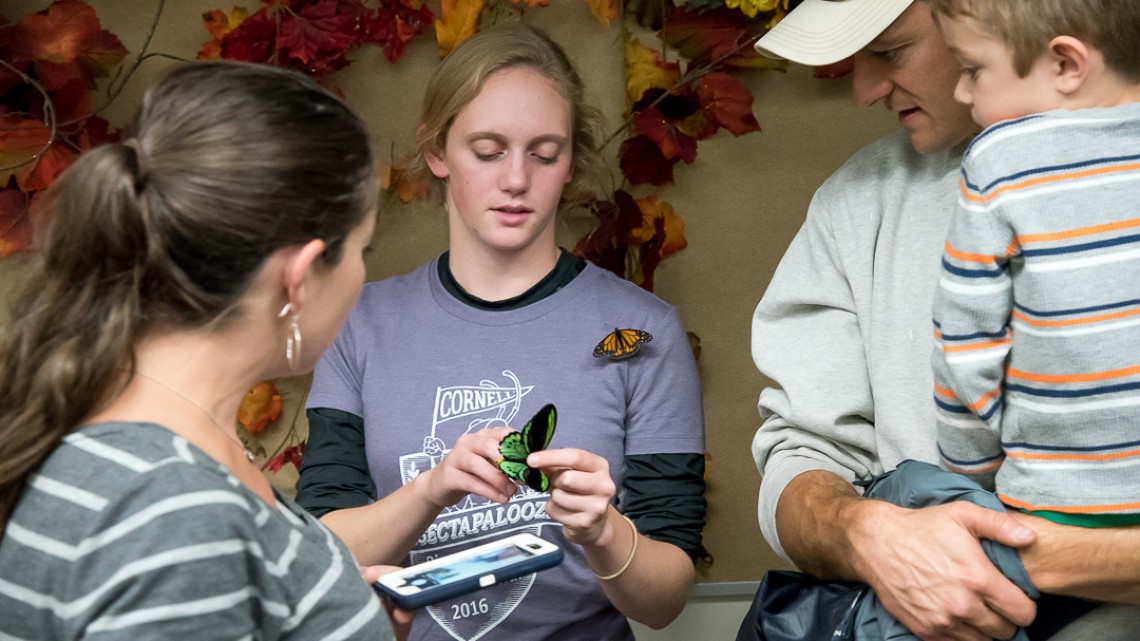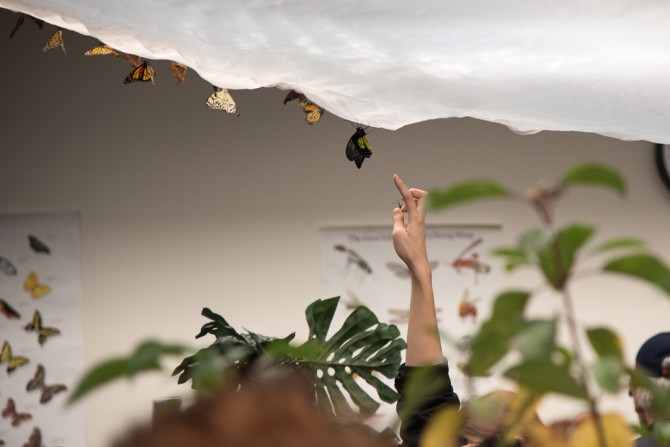
A student explains characteristics of a butterfly during Insectapalooza 2016.
Insectapalooza swarms campus Oct. 28
By Melanie Greaver Cordova
Creepy-crawlers are coming out to play for Insectapalooza 2017, an interactive, hands-on experience for all ages on Oct. 28.
Held from 9 a.m. to 3 p.m. in Comstock Hall, the annual insect fair reflects the ways insects interact with people and affect our lives. Insectapalooza features hundreds of live insects, spiders and other arthropods from the collections of the Department of Entomology in the College of Agriculture and Life Sciences. Entomologists and students will be on hand to explain the behaviors and adaptions of the insect world at the event, which draws up to 2,000 people each year.
Popular attractions include: a butterfly room where visitors can experience free-flying butterflies without the barriers of cages or nets, cockroach races and a face-painting station.
The Arthropod Zoo features exotic creatures like the ogre-faced spider – a tiny creature with enormous eyes that spins webs in its front legs, which it uses like a net to catch prey. Live scorpions, praying mantis, ants, wolf spiders, assassin bugs and other diverse creatures will also be on display, in a way that even people squeamish about bugs can enjoy.
“You can get about as up close and personal as you can imagine, or you can stay at arm’s length,” said Scott McArt, assistant professor of entomology.
Not only can you see bugs like never before, you can hear them as well. New this year is an exhibit called Sounds of Insects that showcases the buzzings, chirpings and clickings of dozens of arthropod species.
Organized by Ashakur Rahaman and Ben Thomas of the Cornell Lab of Ornithology and entomology graduate student Samantha Willden, the exhibit uses recordings from the lab’s Macaulay Library to allow visitors to both hear and “see” sounds. A spectrogram illustrates frequency, loudness and tonal qualities of insects like tree hoppers, cicadas, wasps, honeybees, ants, mole crickets and more.
Linda Rayor, senior lecturer and research associate in entomology and director of the Naturalist Outreach Program, said people are accustomed to hearing insects as part of a larger auditory experience, like the cacophony of a late summer evening. The new exhibit isolates those sounds in a way that Rayor says provides a unique experience of the auditory world of bugs.
At the pollinator exhibit, visitors can explore an entire room with live honeybees, bumblebees, games and interactive displays. You can taste honey made from bees in the room and learn what a pollinator-friendly garden looks like.
Education and knowledge-sharing are key components of the event, McArt said: “Public engagement is critical. We can make an impact if we get information out into the public so they have a chance to do something about issues such as pollinator health.”
Bee expert Emma Mullen, extension associate with the Department of Entomology, agreed: “It’s important to spread knowledge of insects to the wider public because they play such as huge role in our lives, like pollinating crops on the beneficial side and as agricultural pests on the negative side. An event like this lets people see a bigger picture of where their food actually comes from.”
Tickets cost $3 and are free for children age 3 and younger.
Melanie Greaver Cordova is communications coordinator for the College of Agriculture and Life Sciences.
Media Contact
Get Cornell news delivered right to your inbox.
Subscribe